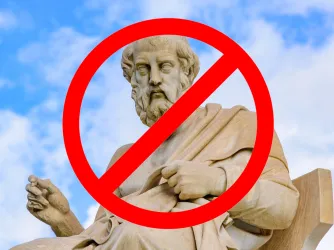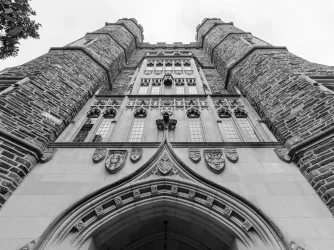Table of Contents
Government attempts to label speech misinformation, disinformation, and malinformation are a free-speech nightmare

Mark Van Scyoc / Shutterstock.com
In April, the Department of Homeland Security unveiled a new board to tackle what the government believed — and still believes — is an existential crisis facing American democracy: disinformation. The Disinformation Governance Board’s creation, however, did not go over well. Comparisons to George Orwell’s “Ministry of Truth” flooded social media.
Within three weeks of its announcement, the board was put on ice and its first executive director, Nina Jankowicz, resigned. The Department of Homeland Security apparently saw how unpopular it was and shuttered it. Nevertheless, the problem of disinformation — and its siblings, misinformation and malinformation — is not going away anytime soon. Just check out the explosive growth of the use of this terminology over the last two decades:

But even if the reported flood of disinformation, misinformation, and malinformation poses a threat to our ability to readily separate truth from falsehood, an overzealous government response that chills or otherwise censors constitutionally protected speech isn’t the answer. In fact, the cure may well be worse than the disease: Allowing the government to decide what speech is and is not fit for public consideration will likely make the problem worse.
In this FIRE explainer, I’ll describe what misinformation, disinformation, and malinformation are; how the government tries to regulate these types of speech; why government responses pose a threat to free speech and expression and will make the problem worse; and what solutions, beyond government intervention, are available.
What is misinformation, disinformation, and malinformation?
Let’s get started by defining our terms.
Disinformation is essentially a lie uttered with malicious intent. The individual or entity speaking knows what they’re saying isn’t true and is intentionally trying to deceive people into believing something false to achieve an objective.
Think, Russia’s Internet Research Agency’s meddling in U.S. elections.
Misinformation occurs when someone inadvertently spreads false information. Unlike disinformation, people who share misinformation do not intend to lie or deceive. Misinformation is spread all the time. People believe many things that aren’t true. You do. I do. We’re human after all. And we talk and write — a lot. So bad information proliferates with no ulterior motives.
For example, if your friend tells you the surprise party for his brother is at 7 p.m. on Saturday, but it’s really at 6 p.m., he’s sharing “misinformation.” He’s wrong, and you might get some annoyed looks strolling in after the surprise, but your friend just made a mistake.
Misinformation and disinformation are kissing cousins. If you’re an agent of disinformation, you’re hoping that you can craft a malicious and false message that’s believable or utilitarian enough that people spread it like wildfire in the media, across social media, and just having everyday conversation with friends, family, and colleagues.
Malinformation is the most Orwellian of the three concepts. The government’s description for this one deserves to be quoted. According to DHS, “malinformation is genuine information, typically private or revealing, that may be distributed in a campaign to cause harm to a person’s reputation in furtherance of the campaign’s objective.”
That’s a useful definition of the term. But it’s also so vague that it can be used to discredit, disparage, or suppress all sorts of speech and expression. For example, campaign ads and investigative journalism may easily fall into this category. They both dig up genuine information on people — both private and revealing — divulge it to the public, and do so for an objective: to win elections or report the truth, respectively.
Giving the government free rein to determine what constitutes “malinformation” — and the power to stifle it — is guaranteed to result in abuse.
How is the government responding to misinformation, disinformation, and malinformation?
Most often, federal and state governments use their bully pulpits to counter information they label as disinformation and misinformation. And they often have the authority to do this — even if they do it in ham-handed or pernicious ways. In certain circumstances — such as combating foreign state-led subterfuge and destabilization campaigns — they may have a responsibility to do so.
But government officials need to tread carefully. Particularly in these polarized times, if citizens see the government cracking down on dissent or playing favorites under the guise of combating “disinformation” or “misinformation,” their trust in government will only be further eroded.
A recent policy analysis from the Cato Institute gives a name to this phenomenon: jawboning. “Government officials can use informal pressure — bullying, threatening, and cajoling — to sway the decisions of private platforms and limit the publication of disfavored speech,” writes Will Duffield. “The use of this informal pressure … is growing. Left unchecked, it threatens to become normalized as an extraconstitutional method of speech regulation.”
Governments risk destroying their credibility as neutral arbiters when they pressure private companies to silence or suppress the speech of organizations and people they don’t like — whether they do so openly or behind closed doors. This campaign of intimidation and coercion disproportionately targets Big Tech, particularly social media companies. And, increasingly, social media companies are caving to the pressure to censor, censure, and suppress expression labeled misinformation, disinformation, and malinformation.
What are the pitfalls of giving the government the power to determine what is misinformation, disinformation, and malinformation?
The world is a complicated place, and any one person or entity having access to the truth is frankly impossible. Instead, knowledge is distributed among many individuals and institutions, which is why the marketplace of ideas is so important.
No one can forecast where the next great idea or innovation will come from. It is only in the give-and-take of this market that we can test ideas and determine which ones make the world a better place — and yes, the right to free speech means that some falsehoods and lies will be introduced into the marketplace of ideas. Still, for knowledge to win, everyone must have the ability to speak, write, and express themselves freely. When government officials enter the marketplace of ideas, it’s critical that they don’t seek to suppress the conversation and pick winners and losers.
Unfortunately, states and the federal government have done just that over the last few years, as they’ve increasingly turned toward regulating what they unilaterally deem misinformation, disinformation, and malinformation.
In 2020, Facebook suppressed the coverage of the Hunter Biden laptop story. On Joe Rogan’s podcast, Facebook CEO Mark Zuckerberg revealed the suppression was due to a vague warning from the FBI about possible “Russian propaganda.” Fifty former intelligence officials also wrote a letter, amplified by the media, stating that the Hunter Biden laptop story was a “Russian information operation” to manipulate the outcome of the 2020 election. Now we know the truth: Emails purportedly from the laptop were authenticated by both The New York Times and The Washington Post.
The fallout of falsely discrediting the truth cannot be overstated: When government interferes in the marketplace of ideas and determines something true is misinformation, disinformation, or malinformation, it treats its citizens like children and gives the impression that certain government officials favor one political party or electoral outcome over another. The result: intensifying tribalism. And what’s stopping government actors from weaponizing that fuzzy concept of malinformation to continue to vilify people and journalists?
The potential for abuse is staggering.
The cure may well be worse than the disease: Allowing the government to decide what speech is and is not fit for public consideration will likely make the problem worse.
Governments, and proponents of government crackdowns on mis- and disinformation, should learn from that other vague, manipulative, and always ripe-for-abuse concept of “hate speech.” What’s hate speech is always in the eye of the beholder. And when the government does the beholding, you can be sure that its judgment will be weaponized to suppress protest, debate, and dissent. That’s why the Supreme Court has repeatedly held that there is no “hate speech” exception to the First Amendment’s free speech protections.
But believing in the marketplace of ideas isn’t the only reason why we should be skeptical of censorial attempts by governments and big companies to shut down speech they don’t like. Allowing all speech out into the world — even the most raucous and contemptible — does a crucial thing: It allows you and I to see the world as it actually is.
If someone’s a racist or a misogynist or a totalitarian, I want to know. I can choose then to engage that person in dialogue and try to convince them that they’re wrong. Or I can simply write them off and refuse to associate with them. Or I can vociferously criticize them. However I choose to respond, knowing who they are and what they believe gives me valuable information about the world.
If I never get to read or hear their speech, I’m left in ignorance and my choices won’t be made with eyes wide open. If we’re to make the best decisions for ourselves, we need more information, not less. This is what FIRE President and CEO Greg Lukianoff calls the “pure informational theory of free speech.”
The idea is really simple: We need to understand as much as possible about what’s in people’s heads. “It is always important to know what people really believe, especially when the belief is perplexing or troubling,” Greg argues. “Conversely, in the overwhelming majority of scenarios you are not safer or better off for knowing less about what people really think.”
How has the government failed to accurately determine what is and isn't misinformation, disinformation, and malinformation over the last few years?
Today’s conspiracy theories sometimes become tomorrow’s facts.
Nowhere was this truer than when it came to determining what was true and false about the coronavirus pandemic and its response. After the vaccines rolled out, many government officials mistakenly told the public that the full course of shots would make it nearly impossible to get sick or transmit COVID-19. Dr. Anthony Fauci, chief medical advisor to President Biden, famously said that the vaccinated would become “dead ends” for the virus.
But it turned out they were wrong. And that’s okay, if unfortunate. That’s science.
The beauty of the scientific method is that it’s a process by which scientists continually try to ascertain the truth, or at least discredit false ideas. But for it to work, scientists — along with journalists and the general public — must have the freedom to express views and share hypotheses, no matter how controversial they are at the time.
During the pandemic, governments routinely short-circuited the scientific process and free inquiry. One example of this was the U.S. government’s treatment of independent journalist Alex Berenson. A prolific tweeter and mRNA vaccine and lockdown skeptic, Berenson became a thorn in the Biden administration’s side.
On July 16, 2021, President Biden told the country that social media companies were “killing people” because their platforms were a haven of COVID-19 misinformation. Hours later, Berenson’s Twitter account was suspended for spreading “misinformation” about the vaccine, seemingly in response to Biden’s comments. By the next month, Berenson was permanently banned after he tweeted this:
In response, Berenson sued Twitter to get his account reinstated.
Documents unearthed during the lawsuit reveal that the Biden administration pressured Twitter to kick Berenson off the platform. And the White House’s efforts worked. But beyond the government applying its awesome power to get what it wanted, its jawboning also deprived the public of what we ultimately learned is accurate information.
We now know that the vaccines do not entirely stop transmission or infection and that debates about COVID-19 vaccine efficacy will likely continue into the foreseeable future. Berenson has since been reinstated on Twitter, and the tweet that got him booted is now, once again, live on the platform. (Note: The publication date of that tweet now reflects the date of Berenson’s reinstatement to Twitter, not the original date of publication.)
Yet, Twitter’s original move to kick him off the platform had cascading effects. People were denied the ability to weigh the argument of a dissenting voice. Maybe this would have changed the behavior of vaccinated people around sick and immunocompromised people, potentially saving lives. It’s hard to know.
Regardless, the government’s behavior in this situation certainly led more and more people to distrust government science, writing it off as partisan and political.
And that is good for no one.
What is the solution to the problem of misinformation, disinformation, and malinformation that doesn't involve state power or contradict a culture of free speech?
Put simply: You’re the solution.
Be more skeptical and, yes, at times, cynical. American democracy is premised on an educated citizenry doing its damnnest to determine what is true and what is false and acting — and voting — accordingly.
If the government is allowed to determine truth and falsehood for its people, we’re no longer citizens but subjects. Deciding for yourself what is true or false is the individual citizen’s responsibility, and this takes time as well as media literacy.
In the end, the more you engage with a diversity of opinions, the better informed you’ll be.
When consuming information, people need to ask questions: Who produced this content and what are their biases? Who is the intended audience of this content? What’s its purpose: to educate, to report, to persuade, to enrage? Does the author use evidence to make their point or appeal to emotion? Does the writer or speaker give the other side their due or engage in character assassination or hyperbole?
People should also engage with a diversity of speech and thought. If you read the New York Times’ editorial coverage of an event, read the Wall Street Journal’s editorial coverage, too. If you watch MSNBC, watch FOX, and vice versa. Even if you think a particular source is wrong or lying, you’ll learn more about what your political opponents think. And knowing how people think might make it easier to persuade them that they’re misinformed or thinking about something the wrong way.
In the end, the more you engage with a diversity of opinions, the better informed you’ll be, and you might even start to see the reasoning behind the other side’s opinion — even if you still ultimately disagree with it. And that can only make our democracy and commitment to free speech, expression, and conscience stronger.
Recent Articles
Get the latest free speech news and analysis from FIRE.

Texas A&M to philosophy professor: Nix Plato or be reassigned

Morgan State says cut the cameras, stop the presses

The worst of both worlds for campus free speech


